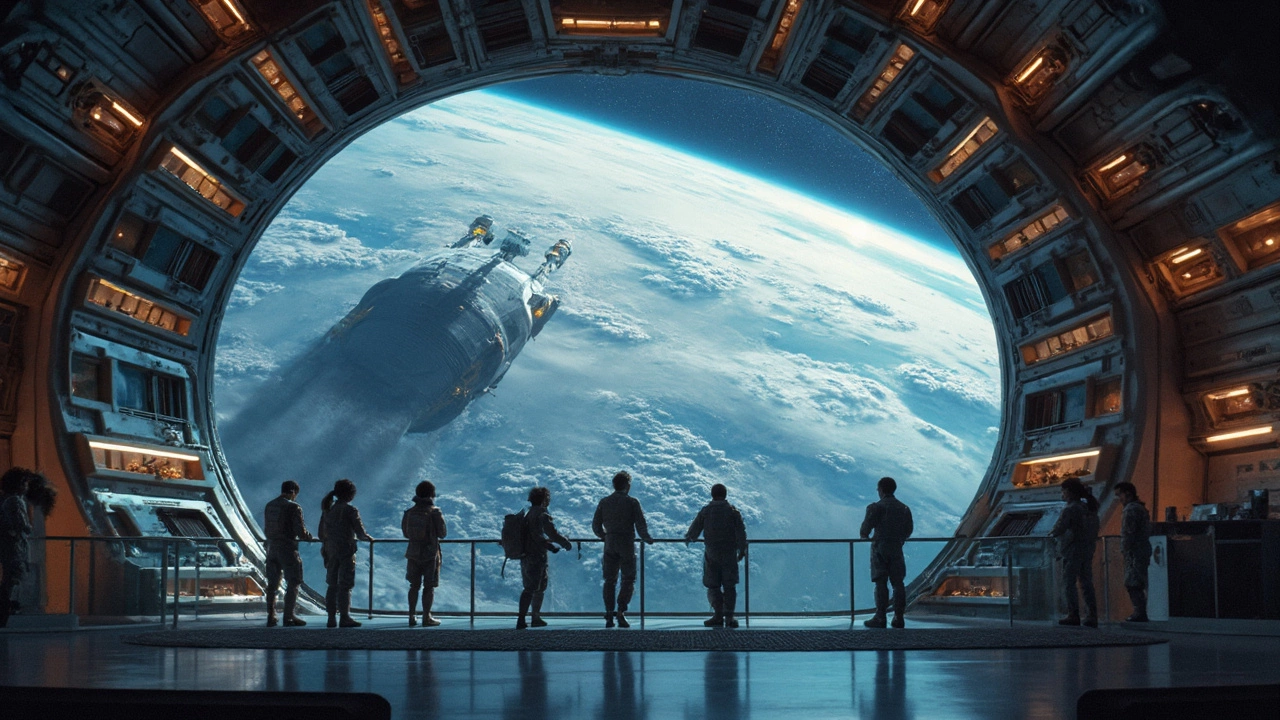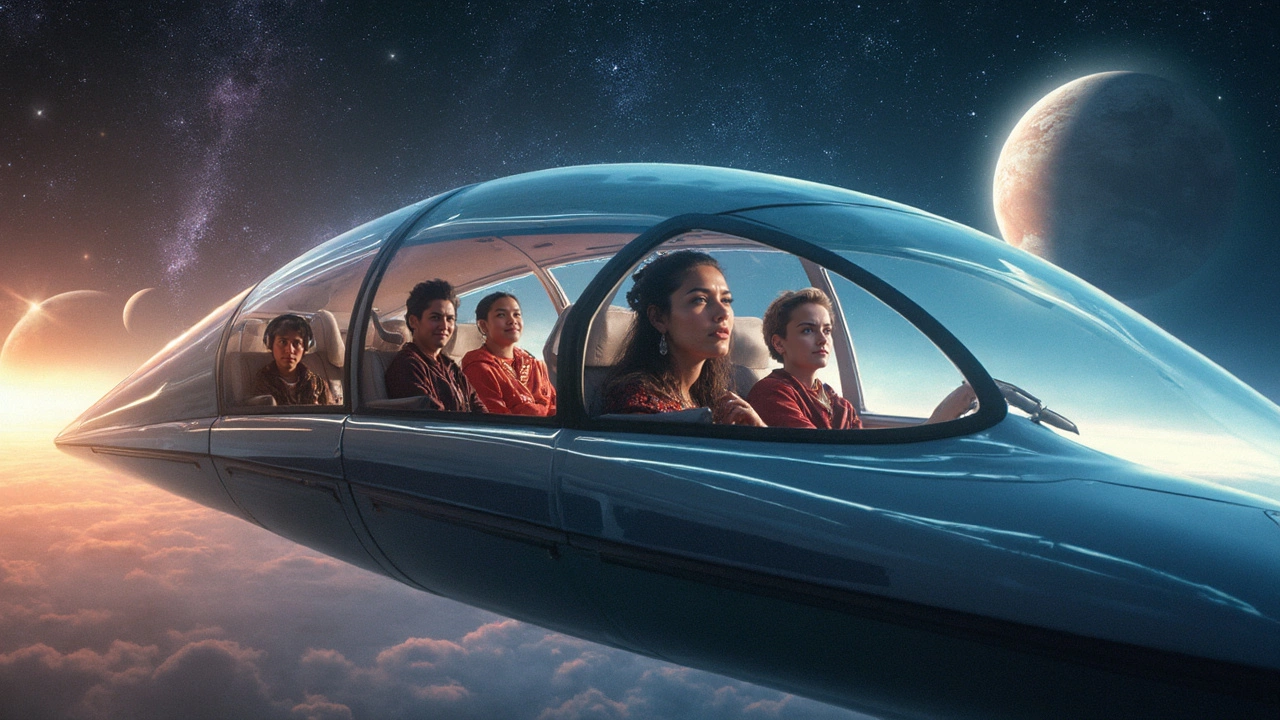Will Humans Live in Space?
 Apr, 11 2025
Apr, 11 2025
Ever dreamt of living among the stars? I mean, really living up there? It might sound like science fiction, but the idea of humans living in space is getting closer to reality than you might think. Let's start with a look at where we are today in terms of space habitats. Right now, the International Space Station (ISS) is the most significant human outpost in space. It circles Earth every 90 minutes, and while it's crammed with scientists and astronauts, it's not exactly the space suburbia we might imagine. But it's a start.
Innovations are on the way to make these space habitats more like home. Think of inflatable modules that expand once in space or a lunar colony that could serve as a springboard to even more distant worlds. We've got the tech for it, or we're pretty close, but what about the challenges of keeping healthy up there? Microgravity does weird things to the human body. Muscle loss, bone density issues, and radiation exposure are just a few things we'd have to tackle. Oh, and don't forget about the psychological side effects of being away from Earth's green fields and oceans.
- Current Space Habitats
- Technological Advancements
- Health Implications
- Role of Private Companies
- International Collaboration
Current Space Habitats
When we talk about space exploration and habitats today, the International Space Station (ISS) is the big player. Floating above Earth at about 400 kilometers, the ISS has been home to astronauts from different countries since 2000. It's like a giant floating science lab where tons of experiments happen every day.
One cool thing about the ISS is how it's a joint effort from five space agencies: NASA, Roscosmos, JAXA, ESA, and CSA. This international collaboration makes it a symbol of what we can achieve together, even when we're not always getting along on the ground.
The ISS offers insights into what living in space might be like. But let's be clear, it’s not a cushy place. We're talking small living quarters, constant noise from machinery, and the constant absence of privacy. It's more cramped dorm than comfy home.
Of course, there are new ideas in the works beyond the ISS. Private companies are stepping up to create new habitats. Take SpaceX's Starship, for example; it’s not just meant for quick trips. They envision a future where it could support longer stays in space.
If we look at concepts like NASA's Gateway project, which is a planned lunar outpost, we get a glimpse of what’s next. This mini-space station will orbit the Moon and could serve as a stepping stone for future Mars expeditions.
So, while we’ve come a long way since landing on the moon over 50 years ago, what we have now are more like test runs. But each of these habitats brings us closer to turning the dream of humans living in space into a reality.
Technological Advancements
When we think about actually living in space, the technology behind it all is mind-blowing. You've seen the cool stuff like rockets blasting off, but there's so much more going on behind the scenes. These days, technological advancements are making the dream of living in space more feasible than ever. From advanced propulsion systems to 3D-printed habitats, the pace of innovation is staggering.
Let's start with propulsion. We're talking about potentially cutting travel times drastically with things like ion thrusters and even experimental nuclear propulsion systems. These could make distant planets feel not so distant anymore.
Then there's the matter of where we'd actually live once we get out there. Companies like SpaceX and Blue Origin are hot on the trail of building Martian habitats and lunar bases. One promising technology is the use of 3D printing. Imagine sending robots to a planet with printers to construct a base using local materials. It's like futuristic Lego sets, but way cooler and on another planet!
And let's not overlook life support systems. They're getting smarter with recycling systems that can convert carbon dioxide back into oxygen and filter urine into clean water. It's like something out of a sci-fi movie, but it's real and essential for sustainable living in space.
The tech side of things doesn't end at survival—it extends into making life comfortable out there too. Researchers are working on ways to protect humans from harsh space radiation, perhaps using magnetic fields or advanced shielding technology. Moreover, artificial gravity concepts, like spinning habitats, are pretty exciting as they'll help keep our bodies functioning closer to how they do on Earth.
These advancements aren't just geared towards scientists and astronauts. The goal here is to make it possible for regular folks to think about human colonization as a real option in the not-so-distant future. Who knows, one day space colonies might be as common as holiday getaways on Earth!

Health Implications
Thinking about living in space sounds exciting, but there are some health implications we need to consider. Microgravity, which is what you experience when floating around in space, can be a real issue. Without gravity pulling on your body, muscles start to weaken, and bones lose calcium, which can lead to problems like osteoporosis, even after astronauts return to Earth.
Then there's the radiation. Earth’s atmosphere protects us from the sun's harmful rays, but in space, that protection isn’t there. So, there's a higher risk of cancer and other health issues. To tackle this, future space exploration missions might need spacecraft with radiation shielding or special habitats to provide some sort of barrier.
The psychological aspect can't be ignored either. Imagine being away from your home planet, family, and friends for months or even years. Isolation and confinement can heighten feelings of loneliness and anxiety. So, maintaining communication with loved ones and having mental health support would be super important for anyone living in space.
Looking at diet, things can get tricky too. Fresh food isn't really a thing in space at the moment. Most meals are packaged, which isn't ideal in the long run. Efforts are underway to grow fresh produce like leafy greens in space, which could solve this problem.
Here's a quick look at the common health challenges faced during space exploration:
- Muscle Atrophy: Regular exercise regimens on special equipment are crucial to combat this.
- Bone Density Loss: Calcium supplements and resistance exercises can help mitigate risks.
- Radiation Exposure: Developing effective shielding methods is a priority.
- Mental Health Strain: Providing recreational activities and regular virtual connections will be key.
- Nutritional Challenges: Innovations in food technology and space farming are on the radar.
In summary, while the challenges are big, they're not insurmountable. Scientists are working on solutions every day, aiming to make living in space as healthy and comfortable as chilling on Earth.
Role of Private Companies
When it comes to space exploration, private companies are shaking things up big time. Companies like SpaceX, Blue Origin, and Virgin Galactic aren't just trying to get people off the ground; they're dreaming of making everyday living in space a thing. With their innovative approaches and chunky investments, they're not just playing catch-up with government agencies like NASA. They're often leading the charge.
SpaceX, led by Elon Musk, has been making headlines with its reusable rockets, which have significantly reduced the cost of launching payloads into space. This is a massive deal because cost has always been one of the biggest barriers to humans living in space. Musk's dream goes beyond just launching satellites: the company is seriously working on sending humans to Mars, aiming to make life multi-planetary. Their Starship rocket, when fully operational, is intended to carry 100 people to the Red Planet. Sounds pretty sci-fi, right?
Then there's Blue Origin, founded by Jeff Bezos. This company is all about making access to space more affordable and reliable, with the ultimate goal of millions of people living and working in space. Their New Shepard rocket has already taken crewed missions safely to the edge of space, paving the way for more significant endeavors. Bezos envisions a future where we harness the resources of the solar system, lifting heavy industries off Earth, which could be a game changer for our planet's sustainability.
Let's not forget Virgin Galactic, which has been focusing on making space tourism a reality. While their flights are suborbital, they're cracking open the door to space for non-astronauts, making the idea of space exploration more relatable and tantalizingly within reach. Their approach also generates essential public interest and investment in space exploration.
Meanwhile, partnerships between these private companies and government agencies are growing stronger. NASA has been actively working with SpaceX and Blue Origin on delivering supplies and even astronauts to the ISS. Such collaboration is setting the stage for future manned missions beyond just our moon.
With their relentless drive and innovations, private companies are complementing—and sometimes surpassing—traditional space programs. They're making space exploration more accessible, sustainable, and, well, kind of cool again. By lowering costs and increasing ambition, they're crucial in our journey toward living in space. Buckle up; it's going to be an exciting ride!

International Collaboration
Imagine if each country tried to conquer space all by itself. Sounds chaotic, right? That's exactly why international collaboration is a big deal in space exploration. It takes a boatload of resources and brainpower to get a spaceship off Earth’s surface, let alone build a habitat out there. So, teaming up is kind of essential.
The ISS is a perfect example. It's not just a U.S. or Russian project; it's a huge group effort involving 15 countries. Space exploration gets a lot of its juice from partnerships. Sharing technology, research, and resources makes tackling big challenges, like living in space, way more doable. And guess what? It's not just about countries anymore. Companies are jumping in, too.
Think about the future of human colonization on the Moon or Mars. The European Space Agency (ESA), NASA, and Roscosmos are already in talks. They discuss stuff like setting up a lunar base that might include shared facilities and tech. All these agencies understand that a united front is the best way forward.
Interestingly, these collaborations also come with their own set of politics. It's not always smooth sailing, but the hope is that working together on such massive projects can even help mend fences back on Earth. With big names like SpaceX and Blue Origin also in the game, backed by national space programs, the dream of humans living in space might just be around the corner, all thanks to teamwork.